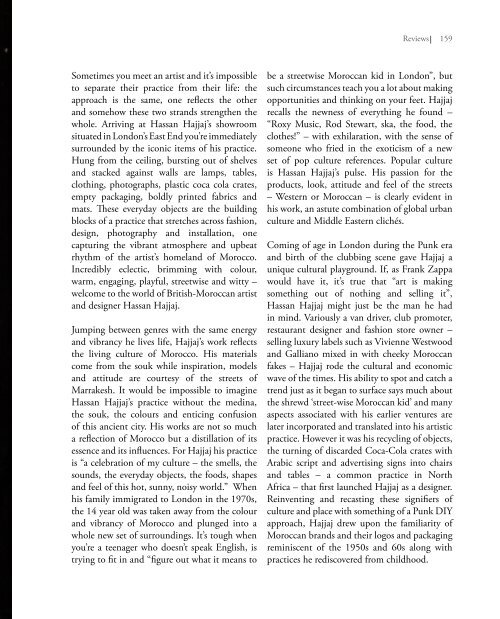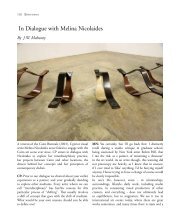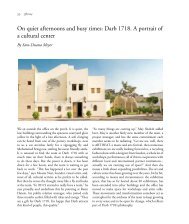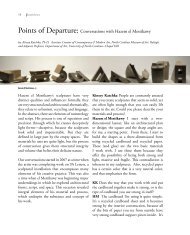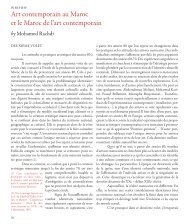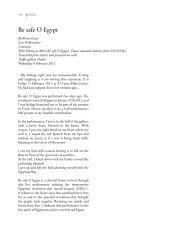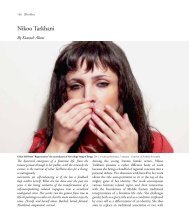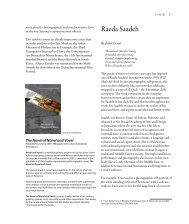HASSAN HAJJAJ COCA COLA RIAD - Contemporary Practices
HASSAN HAJJAJ COCA COLA RIAD - Contemporary Practices
HASSAN HAJJAJ COCA COLA RIAD - Contemporary Practices
You also want an ePaper? Increase the reach of your titles
YUMPU automatically turns print PDFs into web optimized ePapers that Google loves.
Sometimes you meet an artist and it’s impossible<br />
to separate their practice from their life: the<br />
approach is the same, one reflects the other<br />
and somehow these two strands strengthen the<br />
whole. Arriving at Hassan Hajjaj’s showroom<br />
situated in London’s East End you’re immediately<br />
surrounded by the iconic items of his practice.<br />
Hung from the ceiling, bursting out of shelves<br />
and stacked against walls are lamps, tables,<br />
clothing, photographs, plastic coca cola crates,<br />
empty packaging, boldly printed fabrics and<br />
mats. These everyday objects are the building<br />
blocks of a practice that stretches across fashion,<br />
design, photography and installation, one<br />
capturing the vibrant atmosphere and upbeat<br />
rhythm of the artist’s homeland of Morocco.<br />
Incredibly eclectic, brimming with colour,<br />
warm, engaging, playful, streetwise and witty –<br />
welcome to the world of British-Moroccan artist<br />
and designer Hassan Hajjaj.<br />
Jumping between genres with the same energy<br />
and vibrancy he lives life, Hajjaj’s work reflects<br />
the living culture of Morocco. His materials<br />
come from the souk while inspiration, models<br />
and attitude are courtesy of the streets of<br />
Marrakesh. It would be impossible to imagine<br />
Hassan Hajjaj’s practice without the medina,<br />
the souk, the colours and enticing confusion<br />
of this ancient city. His works are not so much<br />
a reflection of Morocco but a distillation of its<br />
essence and its influences. For Hajjaj his practice<br />
is “a celebration of my culture – the smells, the<br />
sounds, the everyday objects, the foods, shapes<br />
and feel of this hot, sunny, noisy world.” When<br />
his family immigrated to London in the 1970s,<br />
the 14 year old was taken away from the colour<br />
and vibrancy of Morocco and plunged into a<br />
whole new set of surroundings. It’s tough when<br />
you’re a teenager who doesn’t speak English, is<br />
trying to fit in and “figure out what it means to<br />
Reviews<br />
159<br />
be a streetwise Moroccan kid in London”, but<br />
such circumstances teach you a lot about making<br />
opportunities and thinking on your feet. Hajjaj<br />
recalls the newness of everything he found –<br />
“Roxy Music, Rod Stewart, ska, the food, the<br />
clothes!” – with exhilaration, with the sense of<br />
someone who fried in the exoticism of a new<br />
set of pop culture references. Popular culture<br />
is Hassan Hajjaj’s pulse. His passion for the<br />
products, look, attitude and feel of the streets<br />
– Western or Moroccan – is clearly evident in<br />
his work, an astute combination of global urban<br />
culture and Middle Eastern clichés.<br />
Coming of age in London during the Punk era<br />
and birth of the clubbing scene gave Hajjaj a<br />
unique cultural playground. If, as Frank Zappa<br />
would have it, it’s true that “art is making<br />
something out of nothing and selling it”,<br />
Hassan Hajjaj might just be the man he had<br />
in mind. Variously a van driver, club promoter,<br />
restaurant designer and fashion store owner –<br />
selling luxury labels such as Vivienne Westwood<br />
and Galliano mixed in with cheeky Moroccan<br />
fakes – Hajjaj rode the cultural and economic<br />
wave of the times. His ability to spot and catch a<br />
trend just as it began to surface says much about<br />
the shrewd ‘street-wise Moroccan kid’ and many<br />
aspects associated with his earlier ventures are<br />
later incorporated and translated into his artistic<br />
practice. However it was his recycling of objects,<br />
the turning of discarded Coca-Cola crates with<br />
Arabic script and advertising signs into chairs<br />
and tables – a common practice in North<br />
Africa – that first launched Hajjaj as a designer.<br />
Reinventing and recasting these signifiers of<br />
culture and place with something of a Punk DIY<br />
approach, Hajjaj drew upon the familiarity of<br />
Moroccan brands and their logos and packaging<br />
reminiscent of the 1950s and 60s along with<br />
practices he rediscovered from childhood.


